Ipswich Ragged Schools /
Merchant House, Silent Street
It was said in the
mid-19th century that parts of Ipswich had a 'Class of boys and girls
who were prevented, either by their debased condition, by the
worthlessness or criminality of their parents, or the tattered state of
their garments, from receiving instruction from any previous school'.
The pupils were reported to be unmanageable, unruly and insubordinate.
Then there was no state or compulsory education; parents who could
afford a private education for their children sent them to a fee-paying
grammar school. Christian religions opened schools for a select few
from their own parish, but most young people went without education.
The philanthropist and
Quaker banker, Richard Dykes Alexander (see Blue
plaques page) set up the Ipswich Ragged School
in a cottage in St Clements Church Lane
in 1849. See the 1881 map on our Street
furniture page re: the Water Works to see it marked 'Sunday
School'. The purpose-built
school in Waterworks Street remains today and came under the influence
of Joshua George Newman who, with his wife Deborah, taught
reading, writing, domestic skills
and craft trades to up to 135 destitute children at a time over
nineteen years at the school. The Boys' School is a
well-known survivor of a bygone era standing on Waterworks
Street, or rather it would stand in the middle of the current
Waterworks
Street, had the fascia not been moved back from the road and the
building
shortened by by about ten feet when the street was widened in 1984
as part of the Ipswich 'Eastern Gyratory' traffic scheme (which also
demolished some fine old buildings and turned
the most ancient part of the town around the Wet Dock into a
race-track).
Ragged Boys' School,
Waterworks Street
 2012 image
2012 image
The rather impressively sited commemorative plaque in
the upper Dutch-style gable shows:
'IPSWICH RAGGED SCHOOL
FOUNDED 1849
RENOVATED 1903'
with
'BOYS SCHOOL' on the stone mullioned windows below. It has
received at
least
a couple of facelifts since then and is now housing accomodation with
accesses
at the side. It was set up by the Quakers who did much philanthropic
work
for the poorest in society during the Industrial Revolution.
 2012
image
2012
image
This photograph from 1960 shows
the original position
of the school standing
shoulder-to-shoulder with its long vanished neighbours on a much
narrower Waterworks Street.
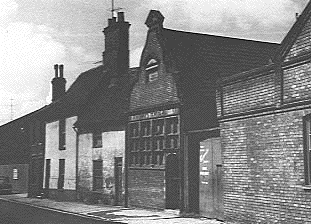 1960 image
1960 image
The Ipswich Society's Local
list (see Reading list) tells us:
"6 Waterworks Street, 1849. Single storey. Red brick with Flemish style
gable end facing road. Stone window and door surrounds. Red concrete
tile roof N. side. Slates S. side.
22 light fixed window with 'BOYS SCHOOL' inscribed on cornice over.
Arch headed doorway with panelled doors set in recess. Stone panel in
gable end inscribed 'RAGGED SCHOOL, FOUNDED 1849, RENOVATED 1903 with
segmental pediment over.
Facade moved back [and truncating of building] to accommodate new
roadline 1984."
Have a look at our Street furniture (Waterworks) page
for an 1881 map which includes the Ragged Boys School.
The Merchant House, Silent
Street
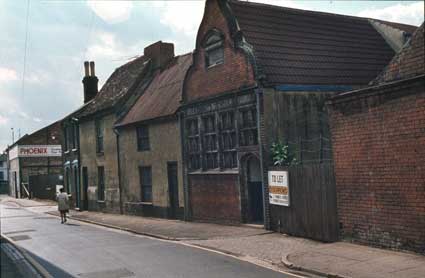 1980s
images courtesy The Ipswich Society
1980s
images courtesy The Ipswich Society
The
pre-Gyratory photograph of the Ragged Boys School shown above – note
how narrow
the street was – reminds us
of some information and images from former Ipswich Society chairman,
Tony Hill, regarding the two buildings immediately south of the school
shown
here: 8 and 10 Waterworks Street. One of the acknowledged features of
the developments and
'improvements' of the sixties and seventies in Ipswich is the almost
careless destruction and loss of a number of historic structures in the
drive to
'modernise' the town. (Indeed, it was the threatened cutting-through of
medieval buildings in St Nicholas Street and Silent Street by a dual
carriageway from the Greyfriars roundabout along Cromwell Street – now
Cromwell Square – towards Star Lane which was the genesis of The
Ipswich
Society and its continuing role in monitoring the old town and the
planning of the future town.)
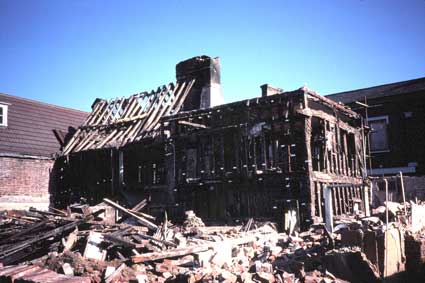
A second
feature of the Ipswich 'modernisation' is a number of successes in
saving
buildings. Tony tells us that the building in Waterworks Street which
stood below the Ragged Boys School was identified as not two, but one
significant
timber-framed structure which might be saved and re-erected. Perhaps
surprisingly – for the early photographs show an rather unpromising
aspect – the inner and outer walls were dismantled and the framework
numbered (note the labels on each timber) and taken down.
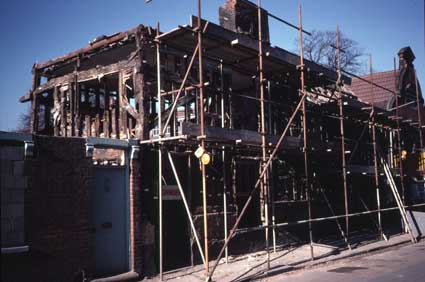
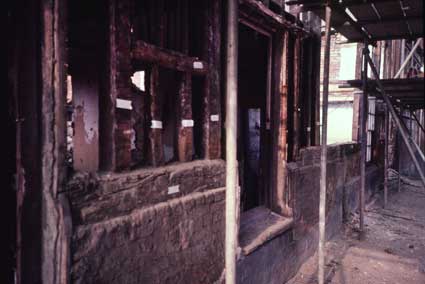
“WATERWORKS STREET
Our Buildings Recording Group’s first task in Waterworks Street turned
out to be much more interesting than anyone had thought possible. At
first glance it seemed that were looking at two separate buildings –
totally different roof lines, odd windows and a hotchpotch of of
brickwork at the back. However, during our initial investigations it
soon became apparent that not only had we found a timber framed
structure all of one build, but also a rather intriguing example of
late 16th century design.
Although we have still to discover the original purpose of the
building, we have already learned a great deal about its construction
and appearance as a result of several members’ energetic assault on the
plaster wall coverings with crowbars and hammers.
This first stripping-out exercise resulted in the discovery of several
original window openings and allowed us to establish the basic wall
formation and plan shape. At the moment we know that we have a two
storied building comprising single ground and first floor rooms at each
side of a central chimney. Below ground floor there are good cellars
each with a fine, but seemingly unused, fireplace. It also seems clear
that the building continued beyond its present junction with the Ragged
School.
Perhaps the most perplexing elements of the design relate to the very
high (2.75 metre) ground floor ceiling height and the way the windows
are positioned high up in the front wall (we have found no evidence of
windows at all on the back wall). One would imagine, perhaps, that the
ground level had, at some time, been lowered but the presence of the
cellars seems to below the theory.
It now seems certain that the buildings will be saved and arrangements
are now being made for its dismantling and re-erection on another site.
I have no doubts at all that much more information will come to light
as the stripping-out proceeds.
Bill Thompson” [Article in the
Ipswich Archaeology Trust newsletter 1984; see Links]
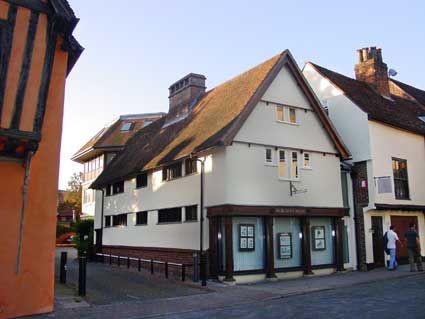 Photograph
courtesy Tony Hill
Photograph
courtesy Tony Hill
Today we might pass the 16th century 'Merchant House' at 11 Silent
Street without
noticing it. Standing on a small plot up the road from the rake of
ancient buildings which include Curson Lodge,
this is the former
neighbour of the Ragged School, reconstructed and with reconfigured
shop front windows. The entrance has been discreetly constructed in the
gap between itself and its neighbour, number 15 (there is no number
13). The modern lettering 'MERCHANT HOUSE' is probably on a fascia
over the bressummer beam which forms part of the shop front.
Ragged
Girls' School,
31-37 Bond Street
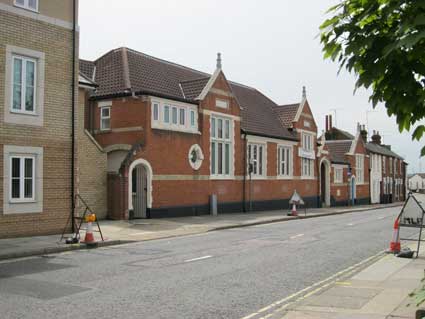 2012 images
2012 images
The Ragged Girls' School stands on the opposite
side to the Boys School and further up the
road in Bond Street. Once used
as
Mick Blackwell's martial arts school, it is now a private nursery. The
building dates from the early twentieth century and it displays several
lettering plaques and is a more recent and impressive
building
than the Boys' School.
The Borough of Ipswich Local List tells us that
the
architects
of the Ragged Girls' School (1900) were Eade and Johns. The right hand
gable is an extension dated 1912. The Local List online entry
continues: 'All windows are casements with white-painted surrounds, and
arches over 2 entrances – one marked ‘Girls’ and the other ‘Boys’, in
same style.'
It would be an obvious assumption that this building was dedicated only
to the education of 'Ragged Girls' (presumably to a job in service)
only, hence the horizontal stone/compound bar built in well above the
main entrance (as shown in the image below). However, it seems clear
that boys and girls were trained at the Ragged School in Waterworks
Street. When the Ipswich School Board started in 1871 that building
became Waterworks Street Infants. It appears that the continuing need
for training of the very poorest children was (re)recognised and the
Bond Street Ragged School was built, presumably for both sexes,
However, no 'Boys' signed entrance is visible from the street, despite
the statement in the Local List.
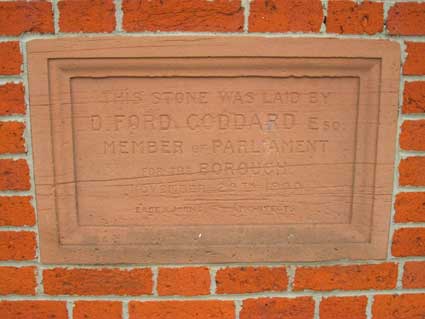 1.
1.  2.
2.
[2. N.B. see our Paul's
malting page for the story of the famous malting company and its
importance to
Ipswich.]
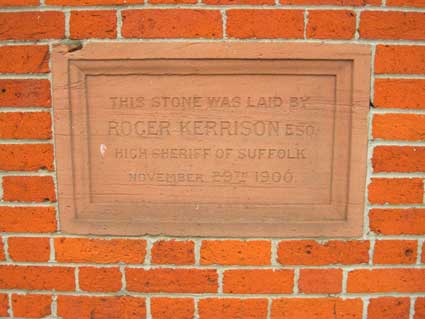 3.
3. 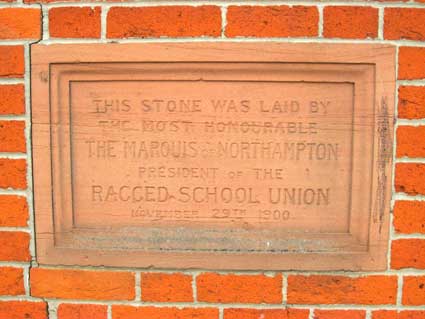 4.
4.
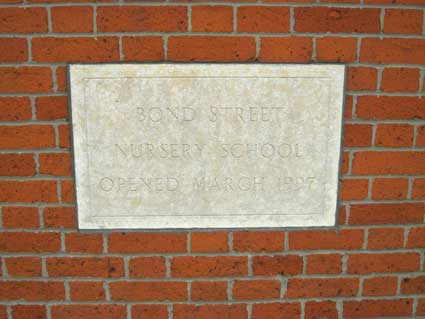 5.
5. 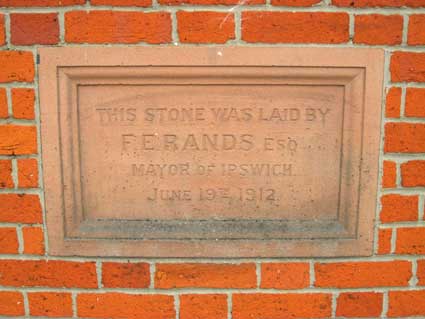 6.
6.
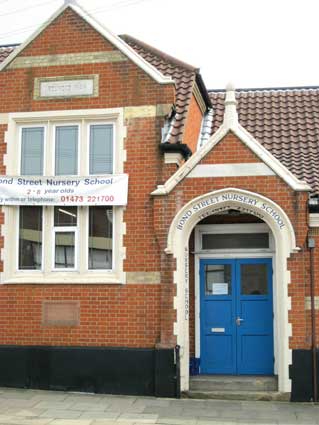
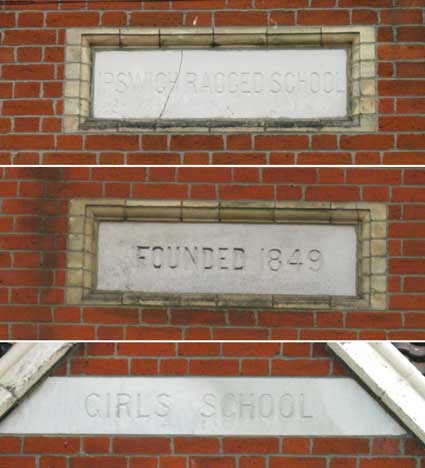 7., 8., 9.
7., 8., 9.
The impressive group of dignitaries named on
these tablets perhaps indicates the growing importance of 'ragged'
education for the very poor in Ipswich at the turn of the 19th century.
Tablets 1. to 4. were clearly laid at the same time, 5. brings us up to
the recent past and 6. indicates that the wing to the right of the main
entrance was added twelve years after the original building.
1.
'THIS STONE WAS LAID BY
D. FORD GODDARD
ESQ.
MEMBER OF PARLIAMENT
FOR THE BOROUGH
NOVEMBER 29TH 1900
EADE & JOHNS ARCHITECTS.'
2.
'THIS STONE WAS LAID BY
W.F.PAUL
ESQ.
MAYOR OF IPSWICH
NOVEMBER 29TH 1900
THEOBALD & SONS BUILDERS NEEDHAM
MARKET.'
3.
'THIS STONE WAS LAID BY
ROGER KERRISON
ESQ.
HIGH SHERRIFF OF SUFFOLK
NOVEMBER 29TH 1900.'
4.
'THIS STONE WAS LAID BY
THE MOST HONOURABLE
THE MARQUIS
OF NORTHAMPTON
PRESIDENT OF THE
RAGGED SCHOOL UNION
NOVEMBER 29TH 1900.'
5.
'BOND STREET
NURSERY SCHOOL
OPENED MARCH 1997'
6.
'THIS STONE WAS LAID BY
F.E. RANDS
ESQ.
MAYOR OF IPSWICH.
JUNE 19TH 1912.'
7. 'IPSWICH
RAGGED SCHOOL'
; 8. 'FOUNDED
1849'
; 9. 'GIRLS SCHOOL'
- Working from left to right in the upper part of
the
building, these lettered panels (7. and 8.) repeat the institution name
and foundation date (as in the earlier building down the road) with 9.
looking in a very good state of preservation.
- W.F. Paul* (see Street
name
derivations) mentioned on number 2. appears as a benefactor of Rosehill Library.
- Goddard and Rands
(1. and 6.) are possible sources for street names (see Street name derivations).
- Roger Kerrison's family on tablet 3. is the
probable source of Kerrison
School (mentioned in an edition of the BBC programme Who Do You Think
You Are? dealing with the antecedents of Tracey Emin) which lies
on the
outskirts of Thorndon village in mid-Suffolk. This was established as a
Reformatory by Sir Edward Kerrison of Brome Hall in 1856 and has been
owned by Suffolk County Council for many years.
See also:
*Wm Paul Tenement Trust housing plaques on our More almshouses page;
Smart Street School;
More schools (Argyle
Street, Clifford Road, Bramford Road, Ranelagh
Road, Spring Road, Springfield Junior, Grey Coat Boys);
Ipswich High
School.
Home
Please email any comments
and contributions by clicking here.
Search Ipswich
Historic Lettering
©2004 Copyright
throughout the Ipswich
Historic Lettering site: Borin Van Loon
No reproduction of text or images without express written permission
 1980s
images courtesy The Ipswich Society
1980s
images courtesy The Ipswich Society 2012 image
2012 image 2012
image
2012
image 1960 image
1960 image 1980s
images courtesy The Ipswich Society
1980s
images courtesy The Ipswich Society


 Photograph
courtesy Tony Hill
Photograph
courtesy Tony Hill 2012 images
2012 images 1.
1.  2.
2. 3.
3.  4.
4. 5.
5.  6.
6.
 7., 8., 9.
7., 8., 9.